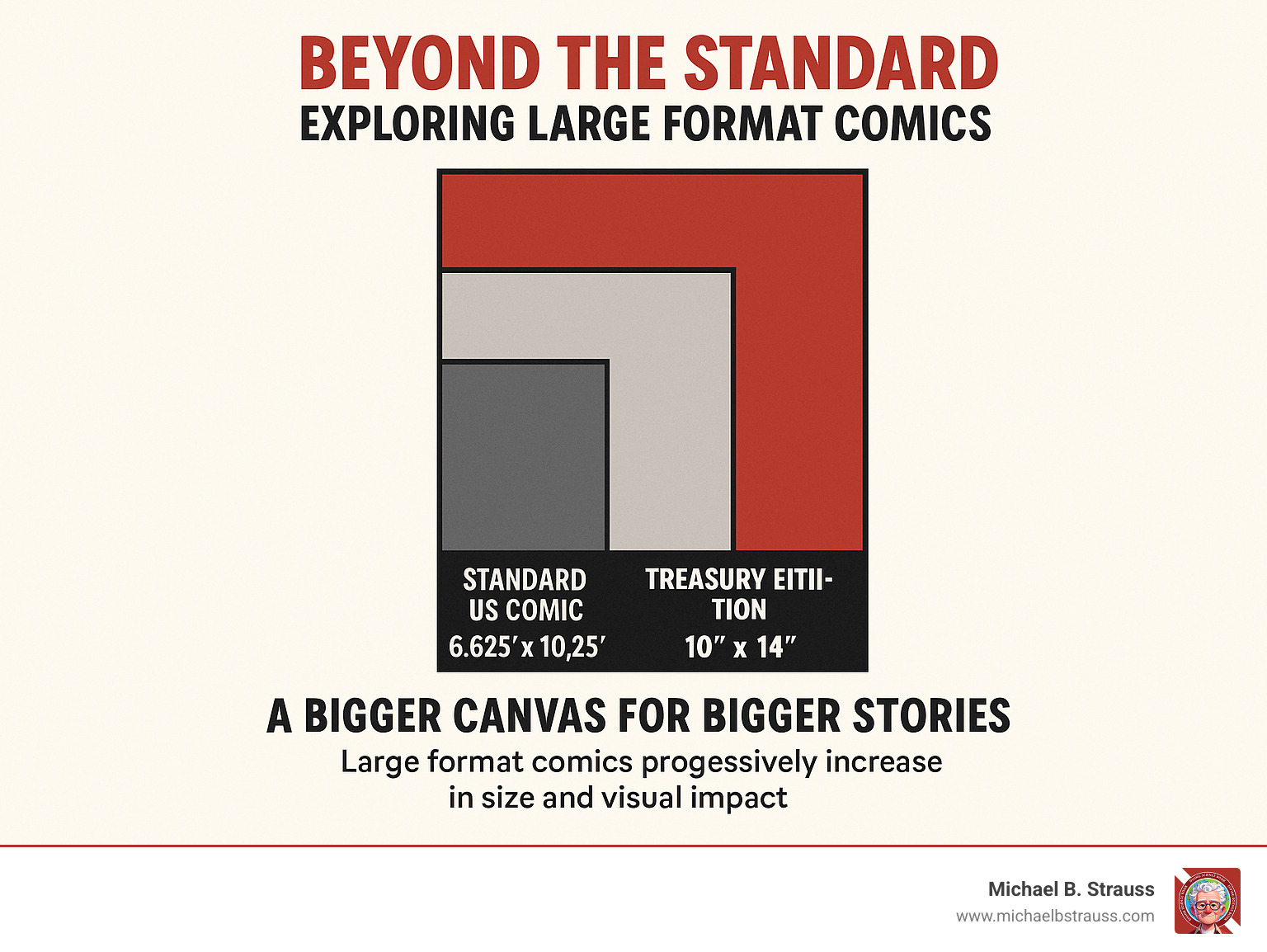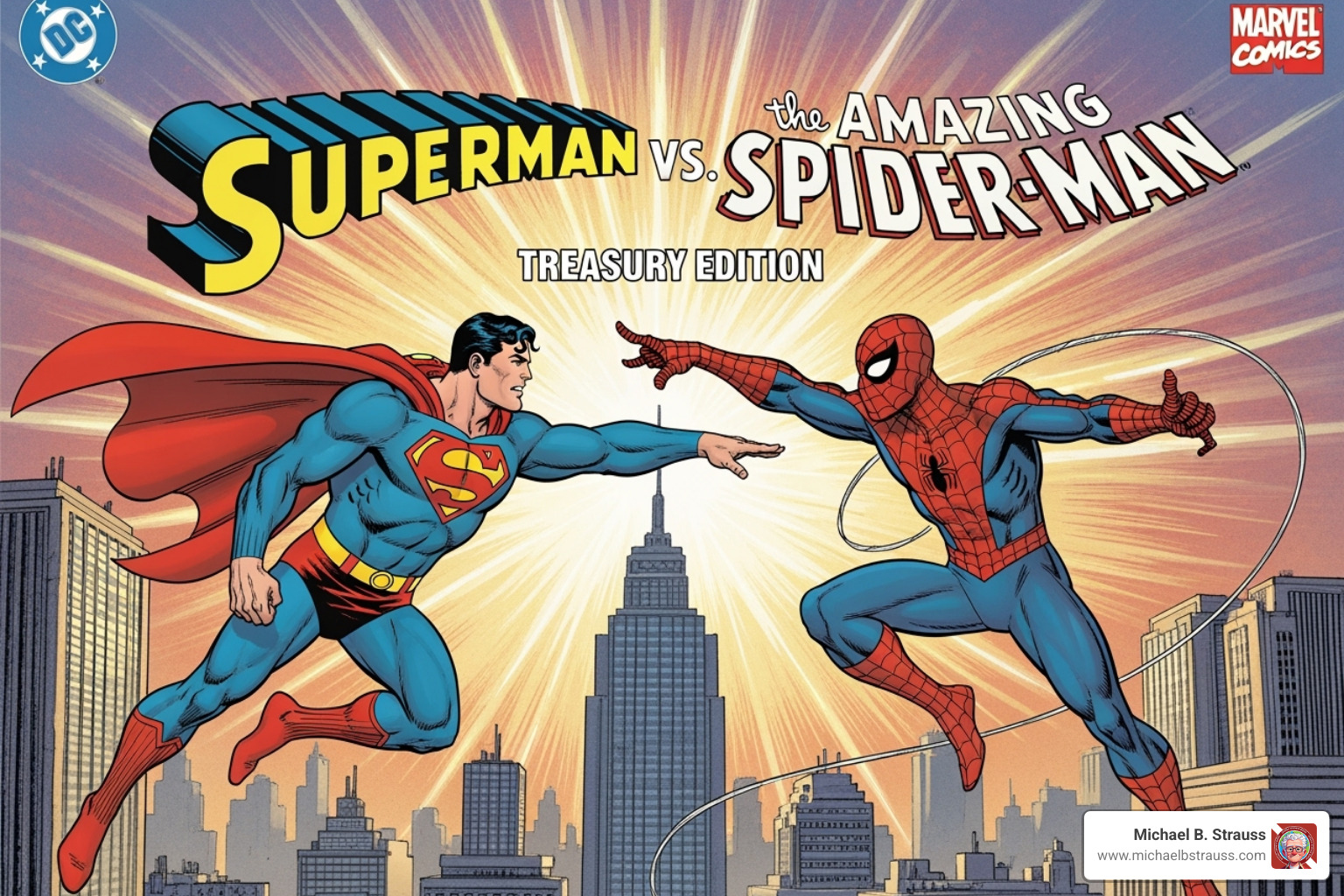Visualizing Adventure on a Grand Scale
From exploring distant galaxies to plunging into the ocean's depths, humanity has always been captivated by grand adventures. But how do we comprehend worlds so much larger than ourselves? One powerful answer lies in visual storytelling, and few formats capture epic scale quite like large format comics.
These are oversized comic books that exceed the standard 6.625" x 10.25" dimensions, typically measuring 10" x 14" (Treasury Editions) or 11" x 17" (modern Giant-Size editions). They offer an unparalleled visual experience, using their expanded canvas to bring ambitious stories to life.
Key characteristics of large format comics:
- Treasury Editions: Classic 10" x 14" format popularized in the 1970s for its newsstand appeal.
- Modern Giant-Size: Contemporary 11" x 17" editions that offer an even more immersive view.
- Detailed Artwork: The larger canvas allows for intricate illustrations and breathtaking panoramic layouts.
- Premium Content: Often used for landmark stories, epic crossovers, and special collections.
- Collector Appeal: High production values make them treasured items, though they present unique storage challenges.
The journey of large format comics began in the 1970s when publishers realized that a bigger size didn't just sell more copies—it fundamentally changed the reading experience. It allowed artists to push the boundaries of their craft, changing a simple story into an immersive world.
This format is a testament to the power of seeing the bigger picture. It's about more than just reading a narrative; it's about diving into a world of detailed artwork and exploring every corner of an artist's vision. Whether depicting a superhero's greatest battle or mapping out a complex environment, large format comics prove that to truly understand a grand adventure, you need a canvas big enough to hold it.

The Golden Age of Giant Comics: Charting Imaginary Worlds
The Rise of the Treasury Edition
Imagine walking into a newsstand in the 1970s. Amid the familiar rows of comics, one stands out—a massive, brilliantly colored book that promises an adventure on a whole new scale. This was the era of the Treasury Edition, a format pioneered by DC Comics with an impressive 10" x 14" comic featuring Rudolph the Red-Nosed Reindeer.
Sol Harrison at DC Comics had finded a powerful truth: large format comics didn't just stand out visually; they made the stories inside feel more significant. In the challenging economic landscape of the 1970s, this was a stroke of genius. The oversized format caught the eye of parents and gave kids a front-row seat to their favorite heroes' greatest adventures.
DC's "Famous First Editions" line, launched in 1974, perfectly leveraged this. Experiencing Superman's or Batman's origin stories on pages nearly twice the standard size gave them a legendary, almost mythic quality.
Marvel Comics soon followed in 1974 with "The Spectacular Spider-Man," reprinting their most iconic stories from the 1960s. The groundbreaking artwork of masters like Steve Ditko and Jack Kirby was finally given the space it deserved, allowing readers to appreciate every detail of the worlds they had created.
These weren't just reprints; they were curated experiences. The format proved perfect for unprecedented collaborations, like the 1975 "Superman vs. Spider-Man: Battle of the Century." This epic crossover demonstrated that the format could host narratives as ambitious as its dimensions, bringing the biggest heroes from rival publishers together for a shared adventure.

The Artistic and Storytelling Revolution
The true innovation of large format comics was how they revolutionized visual storytelling. With nearly double the canvas, artists could think on a different scale. Detailed artwork and panoramic splash pages became tools for deeper world-building and more dynamic action.
Jack Kirby's cosmic sagas felt genuinely vast, while Neal Adams's action sequences gained cinematic impact. Artists weren't just drawing bigger; they were creating more intricate environments and packing more information into every panel. This allowed for epic crossovers with narratives to match.
"Superman vs. Muhammad Ali" (1978) was more than a novelty. The 72-page oversized story explored a complex alien invasion plot and offered subtle social commentary, treating the real-world champion as Superman's equal. The wraparound cover, featuring a crowd of contemporary celebrities, grounded this fantastic event in a recognizable reality, making the story feel both epic and immediate.
Publishers also used the extra space for innovative content. Character dioramas and puzzles turned the comic into an interactive guide to its fictional universe. These elements transformed the reading experience, inviting the audience not just to follow a story but to engage with and explore its world.
Collecting and Reading: The Explorer's Dilemma
When you hold a large format comic, the difference is immediately obvious. The immersive art pulls you in, making every detail of the world visible and impactful. For anyone who appreciates visual clarity, the oversized pages make stories more accessible and engaging. The epic scale makes the adventure feel more significant, drawing you into the action in an almost cinematic way.
From a collector's perspective, original Treasury Editions are artifacts from a pivotal era in publishing history. Landmark crossovers like "Superman vs. The Amazing Spider-Man" are more than just comics; they are cultural touchstones. The high production values give them a substantial feel, like a well-made map to an imaginary land.
However, collecting these giants presents real challenges. Storage challenges are a primary concern, as they require specialized solutions. Their size also makes them more vulnerable to damage, with creases and tears being a constant risk. Finding pristine copies can be difficult, as their unwieldy nature made them prone to wear.
Despite these problems, the pros outweigh the cons for those who value the journey. The immersive reading experience and historical significance make these oversized treasures worth the extra care, preserving a unique way of visualizing and exploring other worlds.
The Modern Renaissance: New Worlds to Explore
Evolution Beyond the Treasury Format
The original Treasury Editions began fading from comic shop shelves by the early 1980s, but their spirit of expansive storytelling lived on. The influence of large format comics inspired graphic novels and European albums to accept larger page sizes, giving creators the freedom to build intricate worlds without compromise.
This shift led to comics being treated as legitimate art objects. Works like "Arkadi and the Lost Titan," a stunning 500-page story in a "Slightly Oversized" format, allow readers to fully immerse themselves in detailed world-building that smaller formats simply couldn't support. This approach recognizes that some adventures need more room to be fully appreciated.
Arkadi and the Lost Titan - Slightly Oversized
Today's Large Format Comics and Special Editions
Modern publishers have acceptd this philosophy, taking the oversized concept to new heights. DC Comics' "Giant-Size Special Editions" measure an incredible 11" x 17", offering an even more cinematic view of their universe. These editions are premium products, featuring high-quality paper, foil variants, and production values that turn each comic into a collector's piece.

Artist's Editions, like DC's "W.I.P." line, take this a step further, presenting raw, uncolored artwork at its original size. This gives fans a behind-the-scenes look at the creative process, much like an explorer's original field notes. Crowdfunding platforms have also shown a massive appetite for premium, oversized comics, proving that readers are eager for experiences that go beyond the standard.
From Fictional Fields to Real-World Depths
Today's large format comics do more than just preserve art; they are pushing the boundaries of how we visualize and understand complex information. The expanded canvas is the perfect medium for tackling detailed subjects, from historical events to scientific concepts, using infographics and detailed illustrations to make intricate topics accessible.
This power of clear, large-scale visualization is essential when exploring any new frontier, whether it's fictional or real. Consider the world beneath the waves—a field as alien, beautiful, and complex as any imagined in a comic book. It's a world of breathtaking vistas and unique life, but also one governed by its own set of rules and risks. To explore it safely requires more than just courage; it requires deep understanding.
Just as a large format comic provides the clarity to appreciate a complex, illustrated world, expert guidance is needed to navigate the intricacies of our own planet's underwater environments. For those fascinated by the science of the deep, comprehensive knowledge is crucial to turn a passion for diving into a safe and unforgettable adventure.
Get the book on diving science here
DISCLAIMER: Articles are for "EDUCATIONAL PURPOSES ONLY", not to be considered advice or recommendations.






